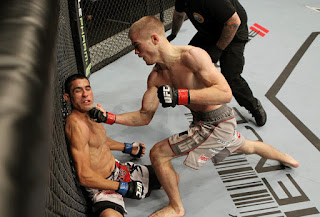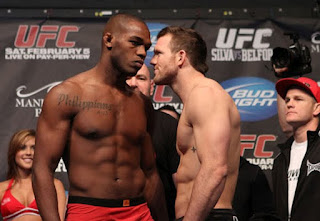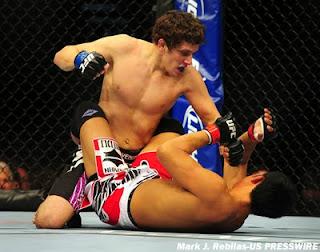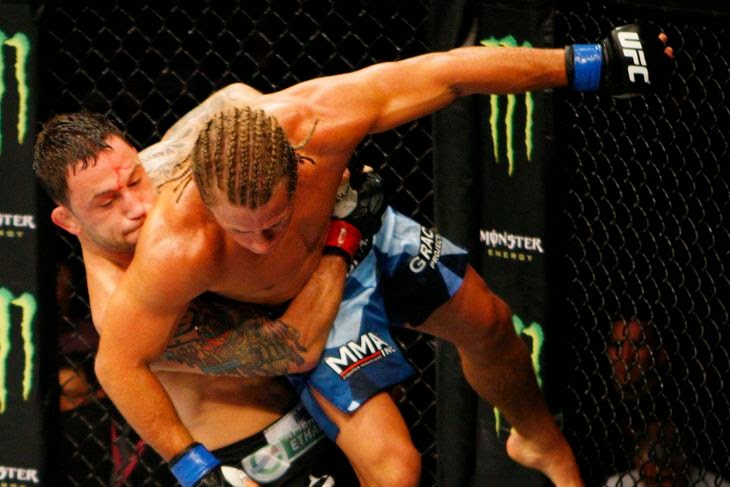One thing that is very special about mixed martial arts is the way that young fighters can step onto the big stage and make their presence felt very quickly. This isn’t like other sports, where veterans often have a hard time stepping aside for their younger counterparts, because in the cage, they will be helped out of the way due to taking a beating. Still, as we watch these fighters mature in the cage, we need to be sure that we don’t push them too high too fast, because not only can that derail a fighter’s career, but it may also throw a wrench into future matchups.
Across the sport you can find a wealth of talented individuals under the age of 25 years old who are performing very well in the Octagon. Rory MacDonald, Paul Sass, John Hathaway, Jim Hettes, Charles Oliveira, and Michael McDonald are just a few of the names that grace this list. You can even include 27-year old Erick Silva as a budding young threat to a number of fighters in his division. As these fighters continue to grow into the potential fame that waits, the UFC should take the slow route that has worked in the past when building up talented fighters.
When you look at these young fighters and their resumes, one thing is apparent: more of these athletes are coming into the UFC with a lot of experience. It is fantastic that these athletes are getting so much experience outside of the UFC before getting the call, because that helps them build solid foundations, and helps them understand what will make them successful in the Octagon. Long gone on the days of Jon Jones and Phil Davis, who stepped into the Octagon with only six and four professional fights respectively. Did that stop them from reaching the points of success that they have today? No it didn’t, but the reason for that is that they were built up slowly over time, which is what the UFC should continue to do.
Jones defeated Andre Gusmao in low key fashion back at UFC 87. He was the underdog when he faced Stephan Bonnar at UFC 94, but it wasn’t until we watched him fling the veteran around the cage and floor him with spinning elbows that people caught a whiff of what he could potentially be. From there, he fought four more individuals who were not top-ranked talent, but still tough tests, to aid in his development each step of the way. Jones continued to ace each test that was placed in front of him until he finally faced a Top 10 opponent in Ryan Bader, another prospect. We all know what happened from that point forward, but the fact is, Jones was given seven very tough fights across a near three-year period before he received his title shot against Mauricio Rua. The UFC knew what they had in Jones and built him up properly into the star he has become today. And in order to protect the long term growth of their young talent, those young fighters who come into the fold and show flashes of something that can be great need to be nurtured correctly.
 One advantage that these fighters have over Jones is that the UFC now has more free television time to work with in order to feature these athletes. Five of Jones first six UFC bouts were featured on free television. It was on this free platform that the UFC showcased him as an emerging fighter, which directed a lot of attention his way. With the deal in place with Fox, and so many different fight cards to fill month in and month out, the UFC should employ the same strategy with these individuals.
One advantage that these fighters have over Jones is that the UFC now has more free television time to work with in order to feature these athletes. Five of Jones first six UFC bouts were featured on free television. It was on this free platform that the UFC showcased him as an emerging fighter, which directed a lot of attention his way. With the deal in place with Fox, and so many different fight cards to fill month in and month out, the UFC should employ the same strategy with these individuals.
Twenty-four year old Stefan Struve is another example of a young combatant who has been built up over time. While he has hit some bumps in the road during his 11-fight UFC run, we’ve watched him grow into a viable heavyweight competitor who is only a few wins away from being considered a top contender. Although he has lost three times by knockout, each time we’ve seen how he has adjusted his game around a weakness and improved as a fighter. Does this automatically mean he will be a champion? No, but he has developed into a viable opponent for anyone in the heavyweight division, as well as a future Fuel TV headliner.
In building up these fighters, matchmakers need to stay away from two types of fights: One type would be a fight that quickly throws a fighter to the wolves. After Rory MacDonald defeated Che Mills, some individuals were calling for him to face Josh Koscheck next, which would be a bad matchup at this time. Koscheck is a Top 10 welterweight, and is the type of veteran fighter who is far from a gatekeeper. While losing to him wouldn’t have destroyed MacDonald’s career, it would have surely taken some of the luster off of his current run at welterweight.
An example of a bout that did that to a young prospect is the Charles Oliveira vs. Jim Miller bout from UFC 124. Miller was on a run at the time, and convincingly defeated the relatively inexperienced “Do Bronx.” Since then he has been able to rebuild his image in a different weight class, but not every prospect would have been able to do the same.
The second kind of fight matchmakers should avoid are bouts that force these prospects to face each other at early points in their run. Hettes and Oliveira are both performing very well in the featherweight division. While a fight between these two would be an interesting matchup, they do not hold the big name status to attract many eyes. It’s safe to assume that this fight would be stashed away on the undercard of a PPV event, when in fact it deserves main card status, or featured on an FX card. Instead of matching them against each other now, give them each 2-3 more fights before placing them across the Octagon from each other. If they are both successful during that time, the UFC will have two viable contenders for a title shot, instead of just one.
 The Jon Jones vs. Ryan Bader fight is an example of a bout that pit young fighters against each other at the right time. Both Jones and Bader were on a tear in the 205-pound division with wins over established names in the weight class, and either fighter would have been considered a top contender with a win over the other.
The Jon Jones vs. Ryan Bader fight is an example of a bout that pit young fighters against each other at the right time. Both Jones and Bader were on a tear in the 205-pound division with wins over established names in the weight class, and either fighter would have been considered a top contender with a win over the other.
What doesn’t work with this slow approach theory is the current rash of injuries that is running rampant across the UFC. If a big opening presented itself and the UFC came calling to a young prospect, it would be hard for that fighter to reject the offer. For example, Michael McDonald would have never turned down the opportunity to face Urijah Faber for the Interim Bantamweight Title after Dominick Cruz was sidelined with an injury, and many people were expecting him to be the replacement. This is why it is important for the management teams of these fighters to make a conscious effort to ensure that these athletes are placed in the kinds of contests against the kinds of opponents that can build their names and brands at the right pace.
As the sport continues to grow, we will see the emergence of more and more young fighters who will take the place of the veterans we have come to love. With patience and calculated matchmaking, the UFC can find itself with a wealth of talent to create great fights with, some of whom may become important personalities within the sport, and drive fan interest for years to come.




